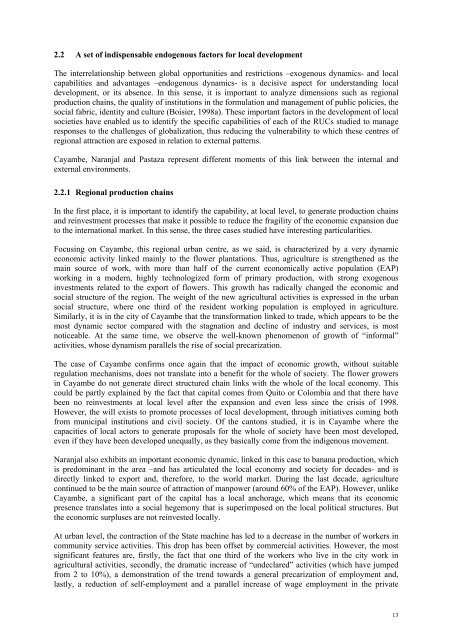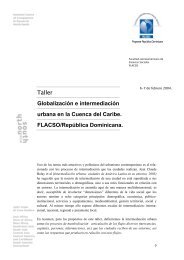interfase urbano-rural en ecuador hacia un desarrollo territorial ...
interfase urbano-rural en ecuador hacia un desarrollo territorial ...
interfase urbano-rural en ecuador hacia un desarrollo territorial ...
You also want an ePaper? Increase the reach of your titles
YUMPU automatically turns print PDFs into web optimized ePapers that Google loves.
2.2 A set of indisp<strong>en</strong>sable <strong>en</strong>dog<strong>en</strong>ous factors for local developm<strong>en</strong>t<br />
The interrelationship betwe<strong>en</strong> global opport<strong>un</strong>ities and restrictions –exog<strong>en</strong>ous dynamics- and local<br />
capabilities and advantages –<strong>en</strong>dog<strong>en</strong>ous dynamics- is a decisive aspect for <strong>un</strong>derstanding local<br />
developm<strong>en</strong>t, or its abs<strong>en</strong>ce. In this s<strong>en</strong>se, it is important to analyze dim<strong>en</strong>sions such as regional<br />
production chains, the quality of institutions in the formulation and managem<strong>en</strong>t of public policies, the<br />
social fabric, id<strong>en</strong>tity and culture (Boisier, 1998a). These important factors in the developm<strong>en</strong>t of local<br />
societies have <strong>en</strong>abled us to id<strong>en</strong>tify the specific capabilities of each of the RUCs studied to manage<br />
responses to the chall<strong>en</strong>ges of globalization, thus reducing the vulnerability to which these c<strong>en</strong>tres of<br />
regional attraction are exposed in relation to external patterns.<br />
Cayambe, Naranjal and Pastaza repres<strong>en</strong>t differ<strong>en</strong>t mom<strong>en</strong>ts of this link betwe<strong>en</strong> the internal and<br />
external <strong>en</strong>vironm<strong>en</strong>ts.<br />
2.2.1 Regional production chains<br />
In the first place, it is important to id<strong>en</strong>tify the capability, at local level, to g<strong>en</strong>erate production chains<br />
and reinvestm<strong>en</strong>t processes that make it possible to reduce the fragility of the economic expansion due<br />
to the international market. In this s<strong>en</strong>se, the three cases studied have interesting particularities.<br />
Focusing on Cayambe, this regional urban c<strong>en</strong>tre, as we said, is characterized by a very dynamic<br />
economic activity linked mainly to the flower plantations. Thus, agriculture is str<strong>en</strong>gth<strong>en</strong>ed as the<br />
main source of work, with more than half of the curr<strong>en</strong>t economically active population (EAP)<br />
working in a modern, highly technologized form of primary production, with strong exog<strong>en</strong>ous<br />
investm<strong>en</strong>ts related to the export of flowers. This growth has radically changed the economic and<br />
social structure of the region. The weight of the new agricultural activities is expressed in the urban<br />
social structure, where one third of the resid<strong>en</strong>t working population is employed in agriculture.<br />
Similarly, it is in the city of Cayambe that the transformation linked to trade, which appears to be the<br />
most dynamic sector compared with the stagnation and decline of industry and services, is most<br />
noticeable. At the same time, we observe the well-known ph<strong>en</strong>om<strong>en</strong>on of growth of “informal”<br />
activities, whose dynamism parallels the rise of social precarization.<br />
The case of Cayambe confirms once again that the impact of economic growth, without suitable<br />
regulation mechanisms, does not translate into a b<strong>en</strong>efit for the whole of society. The flower growers<br />
in Cayambe do not g<strong>en</strong>erate direct structured chain links with the whole of the local economy. This<br />
could be partly explained by the fact that capital comes from Quito or Colombia and that there have<br />
be<strong>en</strong> no reinvestm<strong>en</strong>ts at local level after the expansion and ev<strong>en</strong> less since the crisis of 1998.<br />
However, the will exists to promote processes of local developm<strong>en</strong>t, through initiatives coming both<br />
from m<strong>un</strong>icipal institutions and civil society. Of the cantons studied, it is in Cayambe where the<br />
capacities of local actors to g<strong>en</strong>erate proposals for the whole of society have be<strong>en</strong> most developed,<br />
ev<strong>en</strong> if they have be<strong>en</strong> developed <strong>un</strong>equally, as they basically come from the indig<strong>en</strong>ous movem<strong>en</strong>t.<br />
Naranjal also exhibits an important economic dynamic, linked in this case to banana production, which<br />
is predominant in the area –and has articulated the local economy and society for decades- and is<br />
directly linked to export and, therefore, to the world market. During the last decade, agriculture<br />
continued to be the main source of attraction of manpower (aro<strong>un</strong>d 60% of the EAP). However, <strong>un</strong>like<br />
Cayambe, a significant part of the capital has a local anchorage, which means that its economic<br />
pres<strong>en</strong>ce translates into a social hegemony that is superimposed on the local political structures. But<br />
the economic surpluses are not reinvested locally.<br />
At urban level, the contraction of the State machine has led to a decrease in the number of workers in<br />
comm<strong>un</strong>ity service activities. This drop has be<strong>en</strong> offset by commercial activities. However, the most<br />
significant features are, firstly, the fact that one third of the workers who live in the city work in<br />
agricultural activities, secondly, the dramatic increase of “<strong>un</strong>declared” activities (which have jumped<br />
from 2 to 10%), a demonstration of the tr<strong>en</strong>d towards a g<strong>en</strong>eral precarization of employm<strong>en</strong>t and,<br />
lastly, a reduction of self-employm<strong>en</strong>t and a parallel increase of wage employm<strong>en</strong>t in the private<br />
13




